Updated November 1, 2024
If you’re a carry-on traveller or light packer, chances are there are several multipurpose items on your packing list. Does that include a phone wallet case? If not, or you’re looking to upgrade your phone or a case, the following list of must-have features of a phone wallet case for travel might help you in your search.
Table of Contents
What is a phone wallet case?
A phone wallet case combines the functionality of a wallet and a protective cover for your phone. It contains one or more slots or pockets to house things normally carried in a wallet or purse.
Folio designs open like a book, providing protection to both the front and back of a phone.
Slim versions typically cover the back of the phone, and may have features offering minimal protection for the front.
Designs that accommodate a lanyard or wrist strap offer protection against loss, damage, or theft.
Benefits of a wallet phone case
The main benefit of a phone case is to protect your phone from harm.
- It offers protection from dirt, dust, pollution, germs, rainfall, and sun. It provides a measure of protection from damage from falls or scratches.
- It can extend a phone’s working life.
- It might increase resale value when upgrading.
- Different designs and colours add a touch of style, or changed to reflect one’s mood or wardrobe.
- At a glance, it helps distinguish a phone from others.
A phone wallet case offers the convenience of not having to carry both a wallet and a phone. It can also act as a storage unit, or another place to stash emergency cash.
- In the slot, pocket, or vault, carry an emergency contact card, a piece of ID, a financial card, and some cash when you don’t want to carry a wallet or purse. If you drive, it’s a convenient place to stow your driver’s licence.
- At home or while travelling, carry a single bill to use in an emergency. It could come in handy when other payment methods aren’t accepted, or if a credit card terminal isn’t working. Make sure it doesn’t have any markings or damage, and is a currency and denomination that can be easily used or changed.
- When inserting a physical SIM card, tape your home SIM and SIM card remover tool to the inside of the cover. Or look for a thin holder with slots for SIM cards and a removal tool. With your home SIM and SIM card remover tool behind your phone, It will be at your fingertips as soon as you return to your home country. Chances are you’ll be connected to your home network by the time you reach the terminal.
12 Must-have features of a phone wallet case for travel
1. A secure fit
Chances are it will fit your phone if it’s rated for a specific make and model. Read the reviews from verified purchasers to make sure. The fit should be snug, but flexible enough for the case to be removed without much difficulty.
2. Attractiveness
It looks good, but not so good that it’s a magnet for pickpockets and thieves. Without sacrificing durability and functionality, look for something inexpensive and unpretentious. Also, consider how it will withstand the rigours of everyday use. My first phone wallet case was a cheap case made of silicone. Unfortunately, ‘cheap’ translated into a tired, somewhat grimy look over time and an on/off button that took some persuasion to do its job.
3. Functional and secure
It securely holds what you want to store behind the phone and within the pocket or slots. I once made a hurried purchase of a Poetic Nubuck case. It featured a hidden slot with pull-tab access.
I don’t recommend this design. The slot and pull strap were made of leather that became more pliable with use. The day my driver’s licence slipped out and fell at my feet was the day I purchased my current phone wallet case’s predecessor.
4. The phone’s functionality isn’t limited
It allows complete access to the screen, camera, ports, and controls. Look for references such as “tactile click buttons” or “optimized button profile.” Grappling with hard-to-click buttons is annoying. So is wrangling a flap that can’t stay out of the way when taking pictures. Also, if you have an external battery with integrated charging cords, check that those cords are compatible with the case.
5. Easy access
Credit cards and other financial and identity cards are easy to access, but not so easy that one could inadvertently fall out.
6. Secure grip
It needs to be easy to grip and hold. Look for a textured anti-slip surface and side grip.
7. Wireless charging compatibility
It offers MagSafe compatibility for Apple devices or is compatible with your wireless charging pad, if you use one. Remove your financial and identity cards before charging. Otherwise, they might become unreadable after being subjected to electromagnetic induction.
8. Durability
It’s made of durable materials capable of absorbing shock on impact. Look for reinforced corner bumpers, or air-pocket corners that act as tiny airbags for your phone.
9. Screen protection
A raised bezel on the side grip offers a measure of protection for the screen. Folio cases invariably have a screen cover.
10. Lightweight
It shouldn’t add unnecessary bulk or weight. Check the specifications for the unit’s weight and decide if it’s one you can tolerate.
11. RFID-blocking technology
Does it feature RFID-blocking technology? Some cases offer RFID-protection against electronic pickpocketing of identity and financial cards.
12. Adhesive accessories
Do you use lost-and-found tags? If so, the surface needs to be a able to accommodate an adhesive tag. Do you use a phone tether tab? If you prefer one with adhesive backing, it needs to stick to the inside of the case.
Anti-pickpocket accessories
(i) Phone tether tab
A phone tether tab is a handy little accessory that sits behind a phone in its case. The tab has an attachment point that protrudes through the charging slot, allowing a leash or lanyard to be attached to your body or tethered to a secure attachment point in a pocket, purse, or bag.
There are lots on the market. Mine is from COCASES.
When paired with another accessory, its main function is to prevent damage, loss, and theft.
(ii) Retractable coil
I’ve experimented with various leashes and tether straps to attach a phone to a plastic O-ring sewn into a pocket or purse. On a trip to Africa in 2023, I used a retractable coil with a lobster claw clasp at each end. It worked beautifully.
One lobster claw clasp was attached to the phone tether tab and the other to an O-ring sewn into the lining in a corner of my crossbody purse. It was possible to grab the phone and close the zipper of my purse, almost completely. The retractable coil permitted using the phone to consult Google Maps or receive a call. An added advantage of this arrangement is that the phone remains attached to the bag at all times and is never placed on a tabletop to be stolen or left behind.
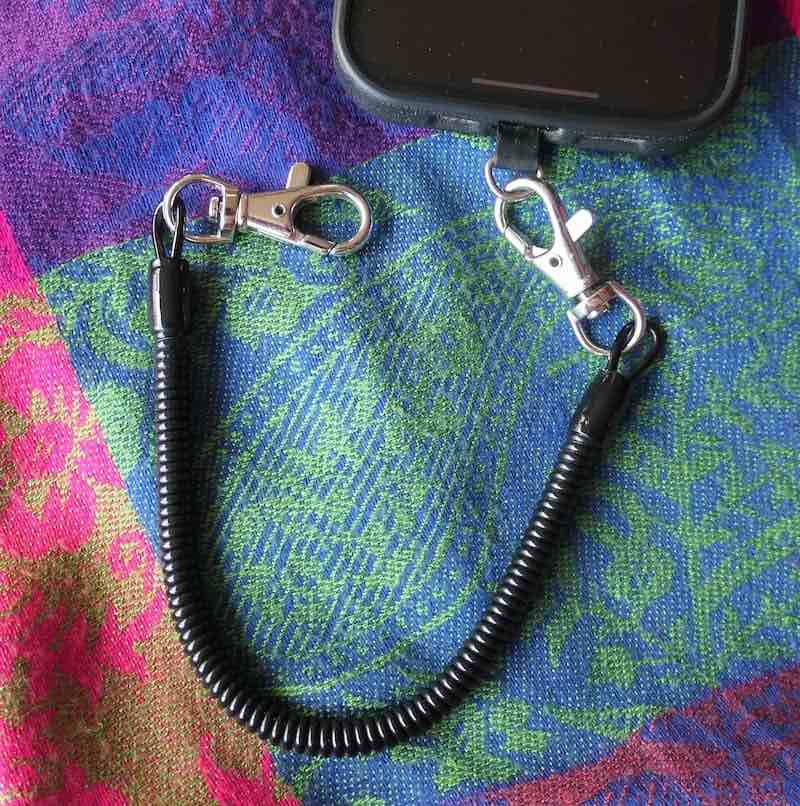
(iii) Lanyard
Some travellers prefer to attach a lanyard to carry the phone around the neck, much like wearing a crossbody bag. A hybrid version combines a lanyard and a small wallet.
There are many versions on the market. Some include a lanyard and wrist strap. A search for “wallet phone case with lanyard” will reveal the possibilities.
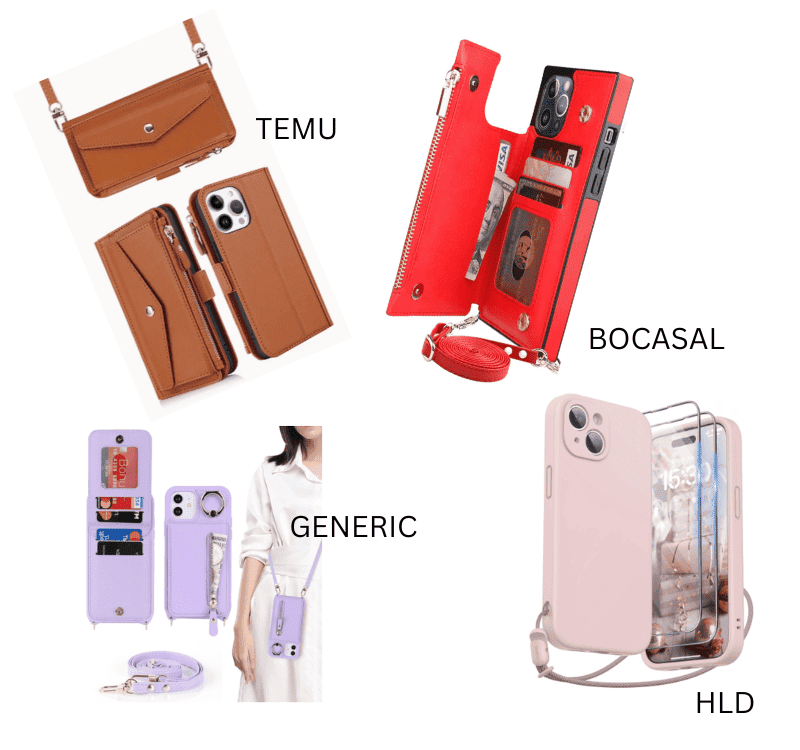
My favourite phone wallet case
I prefer to keep my phone out of sight as much as possible and after several missteps, I finally have something that works for me. It’s a Smartish iPhone 14 Pro – Wallet Slayer Vol. 1. It has a feature I like in a pocket — different sized openings on each side so a card can be pushed or pulled out of the card slot. At 40.8 grams (1.4 ounces), it’s built for packing light travel.
The pocket holds three items securely: a driver’s licence, laminated emergency contact card, and one financial card. A single bill for emergency use is kept inside the cover. For many years, I had the identical version for my previous phone, an iPhone X.
Special mention: Folio phone wallet case
I’m not a fan of the folio design, but my spouse loves it on his iPhone 13. He likes the convenience of going wallet-free with enough slots for a driver’s licence, health card, financial cards, and a banknote. It’s an ICARERCASE iPhone 13 Premium Leather Wallet Case with a magnetic closure for the front cover when it’s not protecting the screen. It weighs 5.3 oz (150 g). Like me, it’s his second purchase. For many years, he had the identical version for his previous phone, an iPhone 7.
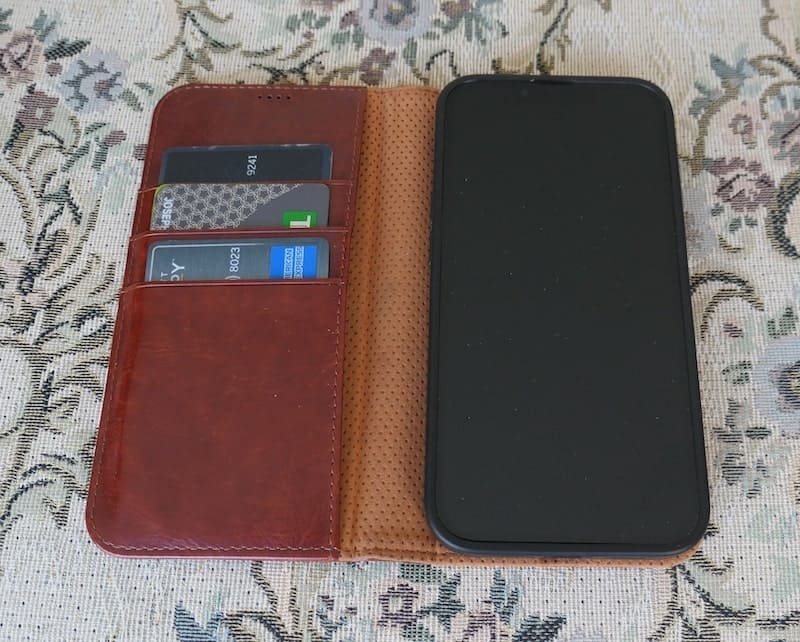
If you found this post helpful, please share it by choosing one or more social media buttons. If you’d like to chime in, or recommend another product, please do so in the comments. Thank you.
Care to pin it for later?
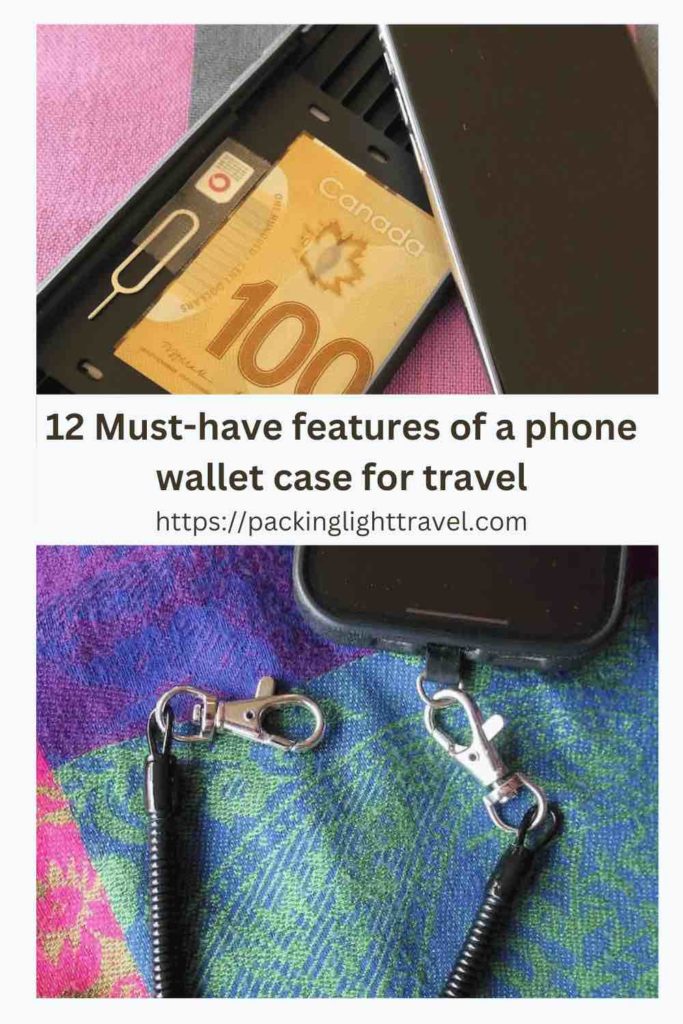
The Amazon links are affiliate links. This means that if you click on one and purchase something, Packing Light Travel earns a small commission which helps with the costs of maintaining the site. Thank you for your support.


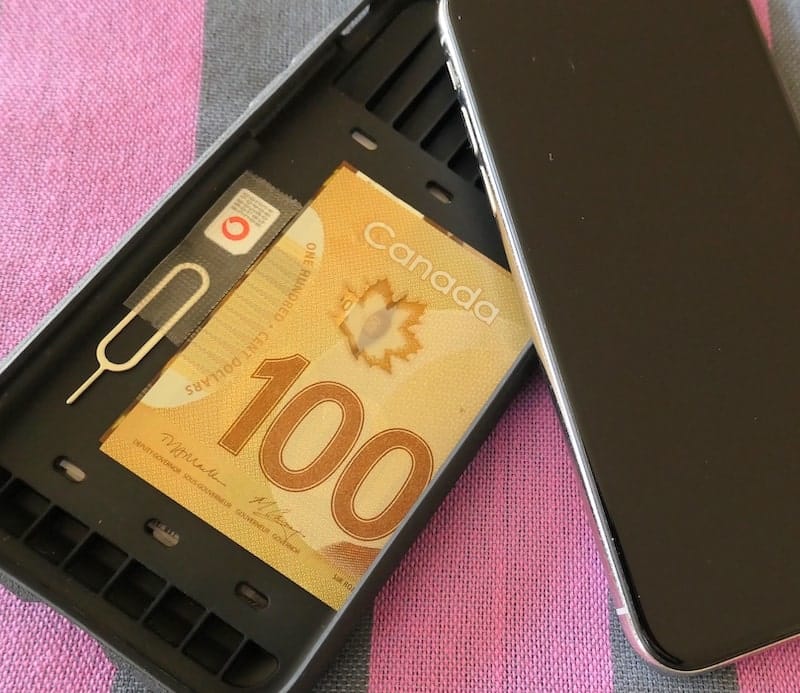
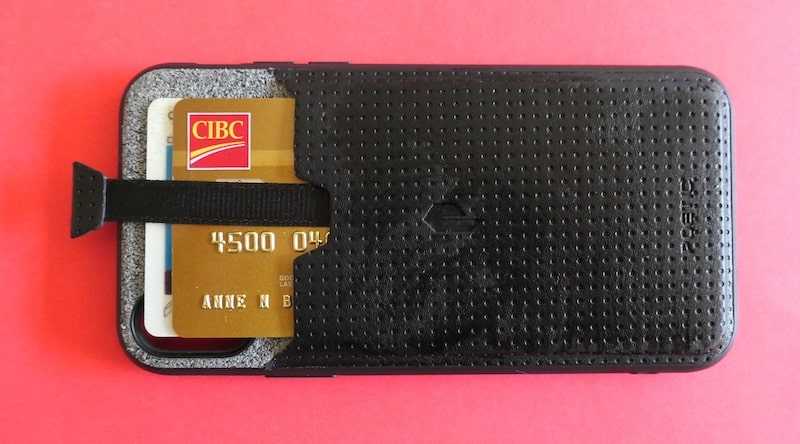
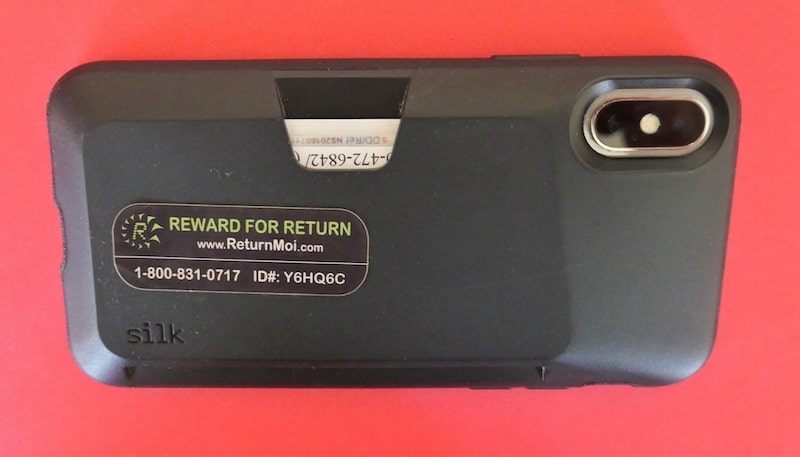





So handy for travel and at home as well.
I must admit that I am always leery about using my phone case for a wallet. I have lost my phone more than once and would hate to lose the wallet too. But I do agree that it offers the convenience of not carrying a purse when you only need a few things. Cool idea to store the SIM remover there. I may have to check out a lost and found tag and try a wallet phone case.
My mum likes to use these type of wallet-cases, but I’ve never considered one. It can be a pain to carry your wallet and phone separately though, so I’ll definitely be looking into getting one for my next trip!
Oh I love this post! Last year I switched to a phone case where I stuck a card pocket on the back (it wasn’t designed as a wallet one) but I can now just grab my phone when I leave the house, rather than rummaging for my purse. It’s so liberating and life-changing! I’m definitely going to look at the more robust wallet style ones you have recommended, I think they will come in handy when I next travel! Thanks for the great suggestions!
Love this idea. Since most of my dresses that I love wearing travelling don’t have pockets and purses can be a target for pick pockets, I struggle to figure out where to put stuff. This wallet on your phone is perfect since my phone is always on me!
As always, very useful information. I especially appreciated the tether suggestion and link. I lost 2! pairs of glasses out of my pocket in one trip on the bumpy roads in Mexico but fortunately not my phone. It would also be very useful when trying to use a phone on chairlifts.
Regarding storage of credit cards, what about using Apple Pay?. In the US and Australia it seems to me very widely adopted, particularly since Covid
Before discovering the tether tab, I would keep my phone in a zippered pouch with its sewn-in tether that I could clip to an attachment point inside a bag or a pocket. I prefer the tether tab for most situations.
Ah Yes, Apple Pay. I must start using this method of payment. As always, thank you for your comments, Geoff.
This is a very bad idea for travellers. If your phone is lost or stolen, your cards are lost and you have lost the ability to use Applepay or Samsungpay.
Hopefullly there will be a second card held securely away from the phone.
1. An ideal wallet phone case for travel should be made of durable material that can withstand wear and tear.
2. It should also be lightweight and compact, so that it can easily fit in a pocket or purse.
3. It should also have enough pockets or compartments to store essential items such as cards, cash, and other documents.
4. It should also have RFID blocking technology to protect personal information from being stolen.
5. Finally, it should have a secure closure to prevent items from falling out.
This is such a helpful guide! I never realized how many features to consider when choosing a phone case
for travel. I love the idea of RFID-blocking technology and the anti-pickpocket accessories—so smart for added security! Also, the Smartish Wallet Slayer sounds like a winner for packing light. I’m going to check out these options before my next trip. Thanks for sharing!